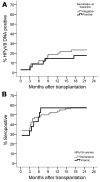Human polyomavirus 9 infection in kidney transplant patients
- PMID: 24866095
- PMCID: PMC4036759
- DOI: 10.3201/eid2006.140055
Human polyomavirus 9 infection in kidney transplant patients
Abstract
Several human polyomaviruses of unknown prevalence and pathogenicity have been identified, including human polyomavirus 9 (HPyV9). To determine rates of HPyV9 infection among immunosuppressed patients, we screened serum samples from 101 kidney transplant patients in the Netherlands for HPyV9 DNA and seroreactivity. A total of 21 patients had positive results for HPyV9 DNA; positivity rates peaked at 3 months after transplantation, but the highest viral loads were measured just after transplantation. During 18 months of follow-up, HPyV9 seroprevalence increased from 33% to 46% among transplant patients; seroprevalence remained stable at ≈30% in a control group of healthy blood donors in whom no HPyV9 DNA was detected. Further analysis revealed an association between detection of HPyV9 and detection of BK polyomavirus but not of cytomegalovirus. Our data indicate that HPyV9 infection is frequent in kidney transplant patients, but the nature of infection-endogenous or donor-derived-and pathogenic potential of this virus remain unknown.
Keywords: BK polyomavirus; BKPyV; HPyV9; immunocompromised host; immunosuppression; kidney transplant; kidney transplantation; kidney-pancreas transplant; polyomavirus; transplant; viruses.
Figures




References
Publication types
MeSH terms
Substances
LinkOut - more resources
Full Text Sources
Other Literature Sources
Medical

